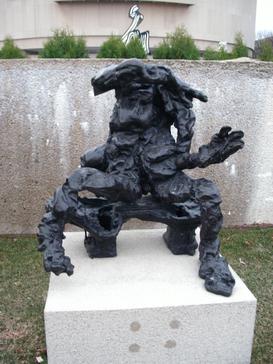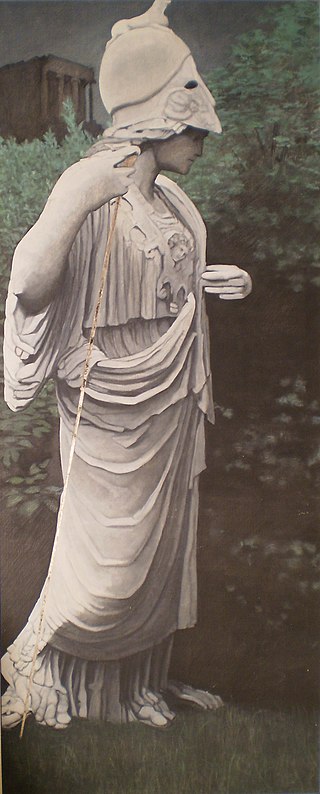Action painting, sometimes called "gestural abstraction", is a style of painting in which paint is spontaneously dribbled, splashed or smeared onto the canvas, rather than being carefully applied. The resulting work often emphasizes the physical act of painting itself as an essential aspect of the finished work or concern of its artist.

Fairfield Porter was an American painter and art critic. He was the fourth of five children of James Porter, an architect, and Ruth Furness Porter, a poet from a literary family. He was the brother of photographer Eliot Porter and the brother-in-law of federal Reclamation Commissioner Michael W. Straus.

The Hirshhorn Museum and Sculpture Garden is an art museum beside the National Mall in Washington, D.C., United States. The museum was initially endowed during the 1960s with the permanent art collection of Joseph H. Hirshhorn. It was designed by architect Gordon Bunshaft and is part of the Smithsonian Institution. It was conceived as the United States' museum of contemporary and modern art and currently focuses its collection-building and exhibition-planning mainly on the post–World War II period, with particular emphasis on art made during the last 50 years.

Elaine Marie Catherine de Kooning was an Abstract Expressionist and Figurative Expressionist painter in the post-World War II era. She wrote extensively on the art of the period and was an editorial associate for Art News magazine.

Clam digging is a North American term for a common way to harvest clams from below the surface of the tidal sand flats or mud flats where they live. It is done both recreationally and commercially. Commercial digging in the U.S. and Canada is colloquially referred to as clamming, and is done by a clammer.

Joseph Herman Hirshhorn was an entrepreneur, financier, and art collector.

Reuben Nakian was an American sculptor and teacher of Armenian extraction. His works' recurring themes are from Greek and Roman mythology. Noted works include Leda and the Swan, The Rape of Lucrece, Hecuba, and The Birth of Venus. He was also commissioned to create portraits of Roosevelt's cabinet in the 1930s.

Robert Engman was an American sculptor with works in the permanent collection of the Hirshhorn Museum, MOMA, the Whitney Museum of American Art, numerous college museums, and private collections.
Elias Goldberg was an American painter.
Michael Loew was an American Abstract Expressionist artist who was born in New York City.

Eros, Inside Eros (1986) is a bronze sculpture by Arman.

The Daguerre Memorial is a bronze and granite sculpture by Jonathan Scott Hartley in Washington, D.C. It was erected in memory of Louis Daguerre.

Seated Woman on a Bench is a bronze sculpture by Willem de Kooning. Modeled in 1972, it was cast in 1976. It is at the Hirshhorn Museum and Sculpture Garden, in Washington, D.C..
Kiepenkerl was originally a sandstone statue of a travelling merchant created by August Schmiemann in Münster, Germany in 1896. Destroyed in World War II, it was re-created in cast metal by Albert Mazzotti Jr in 1953. The statue now stands in a small square in the Old Quarter of Münster. In 1987 American sculptor Jeff Koons created a replica of the design in polished cast stainless steel.
Judith K. Zilczer is an American art historian and former museum curator. She is known for her work with artists such as Horace Pippin, Raymond Duchamp-Villon, Willem de Kooning, and Richard Lindner. Zilczer was interested in the connections between music and art, which she described as "the mystical strain of artistic synesthesia." She curated an exhibit titled "Visual Music: Synaesthesia in Art and Music Since 1900". Zilczer served at the Hirshhorn Museum and Sculpture Garden (HMSG) in various capacities from 1974-2003. In 1978, she organized for the Hirshhorn Museum "The Noble Buyer:" John Quinn Patron of the Avant-Garde, a detailed account of one of the most important collections of modern art assembled in the early years of the 20th Century. From 1992 to 2003, she was Curator of Paintings.
Gandy Brodie was an American painter working primarily in New York City and Townshend, Vermont, during the middle part of the 20th century. He had ties to Abstract Expressionism through artists such as Willem de Kooning and his style, though singular, was considered second-generation Abstract Expressionism. His paintings were influenced by the works of artists such as Camille Corot, Paul Cézanne, Vincent van Gogh, Piet Mondrian, Chaïm Soutine, Georges Rouault, Pablo Picasso, and Paul Klee. Shane Brody, his only child, is a jazz and Americana guitarist who resides in Underhill, Vermont.
Philip Pavia (1911-2005) was a culturally influential American artist of Italian descent, known for his scatter sculpture and figurative abstractions, and the debate he fostered among many of the 20th century's most important art thinkers. A founder of the New York School of Abstract Expressionism, he "did much to shift the epicenter of Modernism from Paris to New York," both as founding organizer of The Club and as founder, editor and publisher of the short-lived but influential art journal It Is: A Magazine for Abstract Art. Reference to the magazine appears in the archives of more than two dozen celebrated art figures, including Picasso, Peggy Guggenheim, and art critic Clement Greenberg. The Club is credited with inspiring art critic Harold Rosenberg’s influential essay “The American Action Painters" and the historic 9th Street Show.

Marcia Marcus is an American figurative painter of portraits, self-portraits, still life, and landscape.
Olga Hirshhorn was an American collector of 19th and 20th century art and supporter of art museums.










